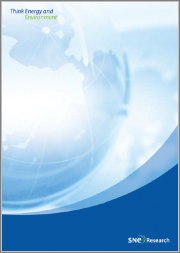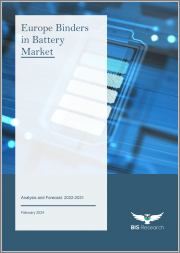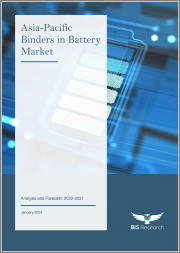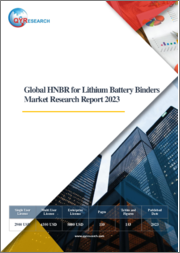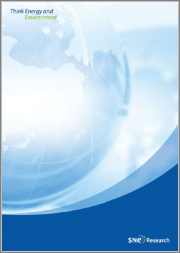
|
시장보고서
상품코드
1612544
세계의 배터리용 바인더 시장 : 유형별, 재료별, 프로세스별, 전지 유형별, 용도별 예측(2025-2030년)Binders in Battery Market by Type (Anode Binder, Cathode Binder), Material (Carboxymethyl Cellulose, Polymethyl Methacrylate, Polyvinylidene Fluoride), Process, Battery Type, Application - Global Forecast 2025-2030 |
||||||
배터리용 바인더 시장은 2023년에 31억 5,000만 달러로 평가되었고, 2024년에는 36억 3,000만 달러에 이를 것으로 예측되며, CAGR 16.25%로 성장하고, 2030년에는 90억 6,000만 달러에 달할 것으로 예상됩니다.
배터리용 바인더 시장은 최신 에너지 저장 솔루션의 성능, 수명 및 효율성을 향상시키는 데 중요한 역할을 합니다. 활물질을 연결하고 충방전 사이클을 통해 구조적 안정성을 확보하기 위해 필수적입니다. 화학적 안정성을 향상시키는 능력이 있기 때문에 리튬 이온 전지 기술에도 차세대 전지 기술에도 필요한 성분입니다. 전기자동차, 휴대용 전자 기기, 그리드 에너지 저장 시스템 수요가 높아지는 가운데, 지속 가능에서 효율적인 에너지 솔루션을 향한 세계의 움직임을 반영하여 바인더의 최종 용도 범위가 확대되고 있습니다.
| 주요 시장 통계 | |
|---|---|
| 기준년(2023) | 31억 5,000만 달러 |
| 추정년(2024) | 36억 3,000만 달러 |
| 예측년(2030) | 90억 6,000만 달러 |
| CAGR(%) | 16.25% |
시장 성장 촉진요인으로는 전기자동차의 보급 확대, 재생 가능 에너지 기술의 진보, 고성능 가전에 대한 요구 증가 등을 들 수 있습니다. 비용 효율적인 바인더 개발에는 많은 기회가 있습니다. 경쟁상 우위를 얻고 환경 문제를 해결하기 위해 생분해성 바인더와 고도 전도성 바인더에 중점을 둔 연구에 투자하는 것이 좋습니다. 바인더 배합에 획기적인 혁신을 가져오고 보다 가볍고 효율적인 배터리로 이어질 수 있습니다.
유망한 전망과는 달리, 시장은 엄격한 규제 프레임워크과 첨단 바인더 재료의 고비용과 같은 과제에 직면하고 있으며, 중소기업의 진입이 제한될 가능성이 있습니다. 화학물질을 개발할 때의 기술적 복잡성은 연구개발에 있어 큰 과제가 되고 있습니다.
조사와 기술 혁신은 이온 전도성, 열 안정성, 내구성 등의 바인더 특성 향상에 초점을 맞추어야 합니다. 광범위한 수신 넣기와 통합을 촉진할 수 있습니다. 전체적으로 바인더 시장의 성격은 역동적이고 진화하고 있으며 급속한 기술 진보와 비용, 성능 및 지속가능성의 균형을 항상 추구하는 것을 특징으로합니다.
시장 역학: 급속히 진화하는 배터리용 바인더 시장의 주요 시장 인사이트 공개
배터리용 바인더 시장은 수요 및 공급의 역동적인 상호작용에 의해 변모를 이루고 있습니다. 새로운 비즈니스 기회를 얻는 데 도움이 될 수 있습니다. 이러한 동향을 종합적으로 파악함으로써 기업은 정치적, 지리적, 기술적, 사회적, 경제적 영역에 걸친 다양한 위험을 완화할 수 있으며, 소비자 행동과 이는 제조 비용과 구매 동향에 미치는 영향을 더욱 명확하게 이해할 수 있습니다.
- 시장 성장 촉진요인
- 다양한 산업에서 반도체 전지 수요 증가
- 배터리용량 개선 및 증가에 대한 요구 증가
- 환경 친화적이고 지속 가능한 바인더 개발
- 시장 성장 억제요인
- 원재료 비용의 변동
- 시장 기회
- 재료 과학의 진보와 바인더 재료의 개량
- 배터리 인프라와 재료를 필요로 하는 스마트 시티 구상 확대
- 시장의 과제
- 배터리 전도성 저하의 가능성
Porter's Five Force : 배터리용 바인더 시장을 탐색하는 전략 도구
Porter's Five Force Framework는 시장 상황경쟁 구도를 이해하는 중요한 도구입니다. 기업이 시장 내 세력도를 평가하고 신규 사업의 수익성을 판단할 수 있도록 도와줍니다. 당신은 더 강인한 시장에서 포지셔닝을 보장할 수 있습니다.
PESTLE 분석 : 배터리용 바인더 시장에서 외부로부터의 영향 파악
외부 거시 환경 요인은 배터리용 바인더 시장의 성과 역학을 형성하는 데 매우 중요한 역할을합니다. 영향을 탐색하는 데 필요한 정보를 제공합니다. PESTLE 요인을 조사하면 기업은 잠재적인 위험과 기회를 더 잘 이해할 수 있습니다. 적극적인 의사 결정을 할 준비가되어 있습니다.
시장 점유율 분석 : 배터리용 바인더 시장 경쟁 구도 파악
배터리용 바인더 시장의 상세한 시장 점유율 분석을 통해 공급업체의 성과를 종합적으로 평가할 수 있습니다. 이를 통해 시장의 집중, 단편화, 통합 동향을 밝혀내고, 벤더는 경쟁이 격화하는 가운데 자신의 지위를 높이는 전략적 의사결정을 하기 위해 필요한 지식을 얻을 수 있습니다.
FPNV 포지셔닝 매트릭스 : 배터리용 바인더 시장에서 공급업체의 성능 평가
FPNV 포지셔닝 매트릭스는 배터리용 바인더 시장에서 공급업체를 평가하는 중요한 도구입니다. 네 가지 사분면을 통해 벤더를 명확하고 정확하게 분할하고 전략 목표에 가장 적합한 파트너 및 솔루션을 파악할 수 있습니다.
전략 분석 및 권장 : 배터리용 바인더 시장에서 성공에 대한 경로를 그립니다.
배터리용 바인더 시장의 전략 분석은 세계 시장에서의 프레즌스 강화를 목표로 하는 기업에 필수적입니다. 이 접근법을 통해 경쟁 구도에서 과제를 극복하고 새로운 비즈니스 기회를 활용하여 장기적인 성공을 거둘 수 있는 체제를 구축할 수 있습니다.
이 보고서는 주요 관심 분야를 포괄하는 시장의 종합적인 분석을 제공합니다.
1. 시장 침투: 현재 시장 환경의 상세한 검토, 주요 기업의 광범위한 데이터, 시장 도달범위 및 전반적인 영향력 평가.
2. 시장 개척도: 신흥 시장의 성장 기회를 파악하고 기존 분야의 확장 가능성을 평가하며 미래 성장을 위한 전략적 로드맵을 제공합니다.
3. 시장 다양화: 최근 제품 출시, 미개척 지역, 업계의 주요 진보, 시장을 형성하는 전략적 투자를 분석합니다.
4. 경쟁 평가 및 정보 : 경쟁 구도를 철저히 분석하여 시장 점유율, 사업 전략, 제품 포트폴리오, 인증, 규제 당국 승인, 특허 동향, 주요 기업의 기술 진보 등을 검증합니다.
5. 제품 개발 및 혁신 : 미래 시장 성장을 가속할 것으로 예상되는 최첨단 기술, R&D 활동, 제품 혁신을 강조합니다.
또한 이해관계자가 충분한 정보를 얻고 의사결정을 할 수 있도록 중요한 질문에 대답하고 있습니다.
1. 현재 시장 규모와 향후 성장 예측은?
2. 최고의 투자 기회를 제공하는 제품, 부문 및 지역은 어디입니까?
3. 시장을 형성하는 주요 기술 동향과 규제의 영향은?
4. 주요 벤더의 시장 점유율과 경쟁 포지션은?
5. 벤더 시장 진입·철수 전략의 원동력이 되는 수익원과 전략적 기회는 무엇인가?
목차
제1장 서문
제2장 조사 방법
제3장 주요 요약
제4장 시장 개요
제5장 시장 인사이트
- 시장 역학
- 성장 촉진요인
- 다양한 업계에서 반도체 전지 수요가 증가
- 배터리용량 개선과 증가의 필요성 증가
- 환경 친화적이고 지속 가능한 바인더 개발
- 억제요인
- 원재료비의 변동
- 기회
- 재료 과학의 진보와 바인더 재료의 개량
- 배터리 인프라와 재료를 필요로 하는 스마트 시티의 대처의 확대
- 과제
- 배터리의 전도성을 저하시킬 가능성
- 성장 촉진요인
- 시장 세분화 분석
- 유형 : 보다 강력한 결합 특성을 가진 양극 바인더의 선호되는 경향
- 소재 : 배터리용 바인더에 있어서의 폴리불화비닐리덴의 사용 증가
- 전지 유형 : 리튬 이온 전지에서의 바인더의 이용 확대
- 용도 : 내구성 향상을 위해 전기자동차 바인더의 용도가 확대
- Porter's Five Forces 분석
- PESTEL 분석
- 정치적
- 경제
- 사교
- 기술적
- 법률상
- 환경
제6장 배터리용 바인더 시장 : 유형별
- 애노드 바인더
- 캐소드 바인더
제7장 배터리용 바인더 시장 : 소재별
- 카르복시메틸셀룰로오스
- 폴리메틸메타크릴레이트
- 폴리불화비닐리덴
- 스티렌-부타디엔 공중합체
제8장 배터리용 바인더 시장 : 프로세스별
- 용제 베이스
- 수성
제9장 배터리용 바인더 시장 : 배터리 유형별
- 납축전지
- 리튬 이온
- 니켈 카드뮴
제10장 배터리용 바인더 시장 : 용도별
- 가전
- 전기자동차
- 에너지 저장
- 산업
제11장 아메리카 배터리용 바인더 시장
- 아르헨티나
- 브라질
- 캐나다
- 멕시코
- 미국
제12장 아시아태평양의 배터리용 바인더 시장
- 호주
- 중국
- 인도
- 인도네시아
- 일본
- 말레이시아
- 필리핀
- 싱가포르
- 한국
- 대만
- 태국
- 베트남
제13장 유럽·중동 및 아프리카 배터리용 바인더 시장
- 덴마크
- 이집트
- 핀란드
- 프랑스
- 독일
- 이스라엘
- 이탈리아
- 네덜란드
- 나이지리아
- 노르웨이
- 폴란드
- 카타르
- 러시아
- 사우디아라비아
- 남아프리카
- 스페인
- 스웨덴
- 스위스
- 터키
- 아랍에미리트(UAE)
- 영국
제14장 경쟁 구도
- 시장 점유율 분석 2023
- FPNV 포지셔닝 매트릭스, 2023
- 경쟁 시나리오 분석
- Zeon, 미국에서의 리튬 이온 배터리용 바인더 생산 준비 개시
- BASF, 리튬 이온 배터리 업계용 애노드 바인더 생산 설비에 투자
- Arkema, 선진적인 전지 셀용으로 새로운 아크릴계 바인더와 첨가제를 발표
- DIC, 리튬 이온 배터리용 수성 음극 바인더 「WATERSOL-LB」를 개발
- 전략 분석과 제안
기업 목록
- Arkema SA
- BASF SE
- Cabot Corporation
- Chongqing Lihong Fine Chemicals Co.,Ltd
- Daikin Industries, Ltd.
- DIC Group
- Elcan Industries Inc.
- Eneos Corporation
- Fujian Blue Ocean & Black Stone Technology Co.,Ltd.
- Fujifilm Holdings Corporation
- Hansol Chemical
- Huntsman Corporation
- Industrial Summit Technology Corp
- Kureha Corporation
- LG Chem Ltd.
- Lubrizol Corporation
- MTI Korea Co., Ltd.
- Nanografi Nano Technology
- Resonac Holdings Corporation.
- Solvay SA
- Sumitomo Seika Chemicals Co., Ltd
- Synthomer PLC
- The Dow Chemical Company
- Trinseo SA
- UBE Corporation
- Zeon Corporation
The Binders in Battery Market was valued at USD 3.15 billion in 2023, expected to reach USD 3.63 billion in 2024, and is projected to grow at a CAGR of 16.25%, to USD 9.06 billion by 2030.
The binder in batteries market plays a crucial role in enhancing the performance, lifespan, and efficiency of modern energy storage solutions. Binders, often made from polymers or resins, are essential in maintaining the integrity of electrodes within batteries, holding active materials together and ensuring structural stability throughout charge-discharge cycles. They are necessary components in both lithium-ion and next-generation battery technologies due to their ability to enhance electrical conductivity, mechanical strength, and chemical stability. With the growing demand for electric vehicles, portable electronics, and grid energy storage systems, the end-use scope of binders has expanded, reflecting the global push toward sustainable and efficient energy solutions.
| KEY MARKET STATISTICS | |
|---|---|
| Base Year [2023] | USD 3.15 billion |
| Estimated Year [2024] | USD 3.63 billion |
| Forecast Year [2030] | USD 9.06 billion |
| CAGR (%) | 16.25% |
Market insights reveal several key growth drivers, such as the increasing adoption of electric vehicles, advancements in renewable energy technologies, and the rising need for high-performance consumer electronics. Opportunities abound in developing eco-friendly and cost-effective binders that can reduce manufacturing costs and improve battery performance. Companies are encouraged to invest in research focusing on biodegradable and high-conductivity binders to gain competitive advantage and address environmental concerns. Advances in nanotechnology and material sciences could provide breakthrough innovations in binder formulations, leading to lighter and more efficient batteries.
Despite the promising outlook, the market faces challenges including stringent regulatory frameworks and the high cost of advanced binder materials, which may limit the entry of smaller companies. Additionally, technological complexities in developing new binder chemistries pose significant R&D challenges. Innovating within the constraints of cost, performance, and sustainability is vital for market players.
Research and innovation should focus on enhancing binder properties such as ionic conductivity, thermal stability, and durability. Collaborative efforts toward developing standardized testing methods could also facilitate broader acceptance and integration of new binder technologies. Overall, the nature of the binder market is dynamic and evolving, characterized by rapid technological advancements and the constant pursuit of balancing cost, performance, and sustainability.
Market Dynamics: Unveiling Key Market Insights in the Rapidly Evolving Binders in Battery Market
The Binders in Battery Market is undergoing transformative changes driven by a dynamic interplay of supply and demand factors. Understanding these evolving market dynamics prepares business organizations to make informed investment decisions, refine strategic decisions, and seize new opportunities. By gaining a comprehensive view of these trends, business organizations can mitigate various risks across political, geographic, technical, social, and economic domains while also gaining a clearer understanding of consumer behavior and its impact on manufacturing costs and purchasing trends.
- Market Drivers
- Rising demand for semiconductor batteries across various industries
- Growing need to improve and increase battery capacity
- Development of eco-friendly and sustainable binders
- Market Restraints
- Fluctuating cost of raw materials
- Market Opportunities
- Advancements in material sciences and improvements in binder material
- Expanding smart city initiatives requiring battery infrastructure and materials
- Market Challenges
- Possibility of reducing the conductivity of the battery
Porter's Five Forces: A Strategic Tool for Navigating the Binders in Battery Market
Porter's five forces framework is a critical tool for understanding the competitive landscape of the Binders in Battery Market. It offers business organizations with a clear methodology for evaluating their competitive positioning and exploring strategic opportunities. This framework helps businesses assess the power dynamics within the market and determine the profitability of new ventures. With these insights, business organizations can leverage their strengths, address weaknesses, and avoid potential challenges, ensuring a more resilient market positioning.
PESTLE Analysis: Navigating External Influences in the Binders in Battery Market
External macro-environmental factors play a pivotal role in shaping the performance dynamics of the Binders in Battery Market. Political, Economic, Social, Technological, Legal, and Environmental factors analysis provides the necessary information to navigate these influences. By examining PESTLE factors, businesses can better understand potential risks and opportunities. This analysis enables business organizations to anticipate changes in regulations, consumer preferences, and economic trends, ensuring they are prepared to make proactive, forward-thinking decisions.
Market Share Analysis: Understanding the Competitive Landscape in the Binders in Battery Market
A detailed market share analysis in the Binders in Battery Market provides a comprehensive assessment of vendors' performance. Companies can identify their competitive positioning by comparing key metrics, including revenue, customer base, and growth rates. This analysis highlights market concentration, fragmentation, and trends in consolidation, offering vendors the insights required to make strategic decisions that enhance their position in an increasingly competitive landscape.
FPNV Positioning Matrix: Evaluating Vendors' Performance in the Binders in Battery Market
The Forefront, Pathfinder, Niche, Vital (FPNV) Positioning Matrix is a critical tool for evaluating vendors within the Binders in Battery Market. This matrix enables business organizations to make well-informed decisions that align with their goals by assessing vendors based on their business strategy and product satisfaction. The four quadrants provide a clear and precise segmentation of vendors, helping users identify the right partners and solutions that best fit their strategic objectives.
Strategy Analysis & Recommendation: Charting a Path to Success in the Binders in Battery Market
A strategic analysis of the Binders in Battery Market is essential for businesses looking to strengthen their global market presence. By reviewing key resources, capabilities, and performance indicators, business organizations can identify growth opportunities and work toward improvement. This approach helps businesses navigate challenges in the competitive landscape and ensures they are well-positioned to capitalize on newer opportunities and drive long-term success.
Key Company Profiles
The report delves into recent significant developments in the Binders in Battery Market, highlighting leading vendors and their innovative profiles. These include Arkema S.A., BASF SE, Cabot Corporation, Chongqing Lihong Fine Chemicals Co.,Ltd, Daikin Industries, Ltd., DIC Group, Elcan Industries Inc., Eneos Corporation, Fujian Blue Ocean & Black Stone Technology Co.,Ltd., Fujifilm Holdings Corporation, Hansol Chemical, Huntsman Corporation, Industrial Summit Technology Corp, Kureha Corporation, LG Chem Ltd., Lubrizol Corporation, MTI Korea Co., Ltd., Nanografi Nano Technology, Resonac Holdings Corporation., Solvay S.A, Sumitomo Seika Chemicals Co., Ltd, Synthomer PLC, The Dow Chemical Company, Trinseo S.A., UBE Corporation, and Zeon Corporation.
Market Segmentation & Coverage
This research report categorizes the Binders in Battery Market to forecast the revenues and analyze trends in each of the following sub-markets:
- Based on Type, market is studied across Anode Binder and Cathode Binder.
- Based on Material, market is studied across Carboxymethyl Cellulose, Polymethyl Methacrylate, Polyvinylidene Fluoride, and Styrene-butadiene Copolymer.
- Based on Process, market is studied across Solvent-based and Water-based.
- Based on Battery Type, market is studied across Lead Acid, Lithium-ion, and Nickel Cadmium.
- Based on Application, market is studied across Consumer Electronics, Electric Vehicle, Energy Storage, and Industrial.
- Based on Region, market is studied across Americas, Asia-Pacific, and Europe, Middle East & Africa. The Americas is further studied across Argentina, Brazil, Canada, Mexico, and United States. The United States is further studied across California, Florida, Illinois, New York, Ohio, Pennsylvania, and Texas. The Asia-Pacific is further studied across Australia, China, India, Indonesia, Japan, Malaysia, Philippines, Singapore, South Korea, Taiwan, Thailand, and Vietnam. The Europe, Middle East & Africa is further studied across Denmark, Egypt, Finland, France, Germany, Israel, Italy, Netherlands, Nigeria, Norway, Poland, Qatar, Russia, Saudi Arabia, South Africa, Spain, Sweden, Switzerland, Turkey, United Arab Emirates, and United Kingdom.
The report offers a comprehensive analysis of the market, covering key focus areas:
1. Market Penetration: A detailed review of the current market environment, including extensive data from top industry players, evaluating their market reach and overall influence.
2. Market Development: Identifies growth opportunities in emerging markets and assesses expansion potential in established sectors, providing a strategic roadmap for future growth.
3. Market Diversification: Analyzes recent product launches, untapped geographic regions, major industry advancements, and strategic investments reshaping the market.
4. Competitive Assessment & Intelligence: Provides a thorough analysis of the competitive landscape, examining market share, business strategies, product portfolios, certifications, regulatory approvals, patent trends, and technological advancements of key players.
5. Product Development & Innovation: Highlights cutting-edge technologies, R&D activities, and product innovations expected to drive future market growth.
The report also answers critical questions to aid stakeholders in making informed decisions:
1. What is the current market size, and what is the forecasted growth?
2. Which products, segments, and regions offer the best investment opportunities?
3. What are the key technology trends and regulatory influences shaping the market?
4. How do leading vendors rank in terms of market share and competitive positioning?
5. What revenue sources and strategic opportunities drive vendors' market entry or exit strategies?
Table of Contents
1. Preface
- 1.1. Objectives of the Study
- 1.2. Market Segmentation & Coverage
- 1.3. Years Considered for the Study
- 1.4. Currency & Pricing
- 1.5. Language
- 1.6. Stakeholders
2. Research Methodology
- 2.1. Define: Research Objective
- 2.2. Determine: Research Design
- 2.3. Prepare: Research Instrument
- 2.4. Collect: Data Source
- 2.5. Analyze: Data Interpretation
- 2.6. Formulate: Data Verification
- 2.7. Publish: Research Report
- 2.8. Repeat: Report Update
3. Executive Summary
4. Market Overview
5. Market Insights
- 5.1. Market Dynamics
- 5.1.1. Drivers
- 5.1.1.1. Rising demand for semiconductor batteries across various industries
- 5.1.1.2. Growing need to improve and increase battery capacity
- 5.1.1.3. Development of eco-friendly and sustainable binders
- 5.1.2. Restraints
- 5.1.2.1. Fluctuating cost of raw materials
- 5.1.3. Opportunities
- 5.1.3.1. Advancements in material sciences and improvements in binder material
- 5.1.3.2. Expanding smart city initiatives requiring battery infrastructure and materials
- 5.1.4. Challenges
- 5.1.4.1. Possibility of reducing the conductivity of the battery
- 5.1.1. Drivers
- 5.2. Market Segmentation Analysis
- 5.2.1. Type: Rising preference for cathode binder for stronger binding properties
- 5.2.2. Material: Increasing usage of polyvinylidene fluoride in binders in battery
- 5.2.3. Battery Type: Expanding utilization of binders in lithium-ion batteries
- 5.2.4. Application: Growing application of binders in electric vehicles for durability
- 5.3. Porter's Five Forces Analysis
- 5.3.1. Threat of New Entrants
- 5.3.2. Threat of Substitutes
- 5.3.3. Bargaining Power of Customers
- 5.3.4. Bargaining Power of Suppliers
- 5.3.5. Industry Rivalry
- 5.4. PESTLE Analysis
- 5.4.1. Political
- 5.4.2. Economic
- 5.4.3. Social
- 5.4.4. Technological
- 5.4.5. Legal
- 5.4.6. Environmental
6. Binders in Battery Market, by Type
- 6.1. Introduction
- 6.2. Anode Binder
- 6.3. Cathode Binder
7. Binders in Battery Market, by Material
- 7.1. Introduction
- 7.2. Carboxymethyl Cellulose
- 7.3. Polymethyl Methacrylate
- 7.4. Polyvinylidene Fluoride
- 7.5. Styrene-butadiene Copolymer
8. Binders in Battery Market, by Process
- 8.1. Introduction
- 8.2. Solvent-based
- 8.3. Water-based
9. Binders in Battery Market, by Battery Type
- 9.1. Introduction
- 9.2. Lead Acid
- 9.3. Lithium-ion
- 9.4. Nickel Cadmium
10. Binders in Battery Market, by Application
- 10.1. Introduction
- 10.2. Consumer Electronics
- 10.3. Electric Vehicle
- 10.4. Energy Storage
- 10.5. Industrial
11. Americas Binders in Battery Market
- 11.1. Introduction
- 11.2. Argentina
- 11.3. Brazil
- 11.4. Canada
- 11.5. Mexico
- 11.6. United States
12. Asia-Pacific Binders in Battery Market
- 12.1. Introduction
- 12.2. Australia
- 12.3. China
- 12.4. India
- 12.5. Indonesia
- 12.6. Japan
- 12.7. Malaysia
- 12.8. Philippines
- 12.9. Singapore
- 12.10. South Korea
- 12.11. Taiwan
- 12.12. Thailand
- 12.13. Vietnam
13. Europe, Middle East & Africa Binders in Battery Market
- 13.1. Introduction
- 13.2. Denmark
- 13.3. Egypt
- 13.4. Finland
- 13.5. France
- 13.6. Germany
- 13.7. Israel
- 13.8. Italy
- 13.9. Netherlands
- 13.10. Nigeria
- 13.11. Norway
- 13.12. Poland
- 13.13. Qatar
- 13.14. Russia
- 13.15. Saudi Arabia
- 13.16. South Africa
- 13.17. Spain
- 13.18. Sweden
- 13.19. Switzerland
- 13.20. Turkey
- 13.21. United Arab Emirates
- 13.22. United Kingdom
14. Competitive Landscape
- 14.1. Market Share Analysis, 2023
- 14.2. FPNV Positioning Matrix, 2023
- 14.3. Competitive Scenario Analysis
- 14.3.1. Zeon begins preparations for US Li-ion battery binder production
- 14.3.2. BASF to invest in anode binder production assets for the lithium-ion battery industry
- 14.3.3. Arkema introduces new acrylic-based binders and additives for advanced battery cells
- 14.3.4. DIC Develops WATERSOL-LB Waterborne Anode Binder for LiBs
- 14.4. Strategy Analysis & Recommendation
Companies Mentioned
- 1. Arkema S.A.
- 2. BASF SE
- 3. Cabot Corporation
- 4. Chongqing Lihong Fine Chemicals Co.,Ltd
- 5. Daikin Industries, Ltd.
- 6. DIC Group
- 7. Elcan Industries Inc.
- 8. Eneos Corporation
- 9. Fujian Blue Ocean & Black Stone Technology Co.,Ltd.
- 10. Fujifilm Holdings Corporation
- 11. Hansol Chemical
- 12. Huntsman Corporation
- 13. Industrial Summit Technology Corp
- 14. Kureha Corporation
- 15. LG Chem Ltd.
- 16. Lubrizol Corporation
- 17. MTI Korea Co., Ltd.
- 18. Nanografi Nano Technology
- 19. Resonac Holdings Corporation.
- 20. Solvay S.A
- 21. Sumitomo Seika Chemicals Co., Ltd
- 22. Synthomer PLC
- 23. The Dow Chemical Company
- 24. Trinseo S.A.
- 25. UBE Corporation
- 26. Zeon Corporation







